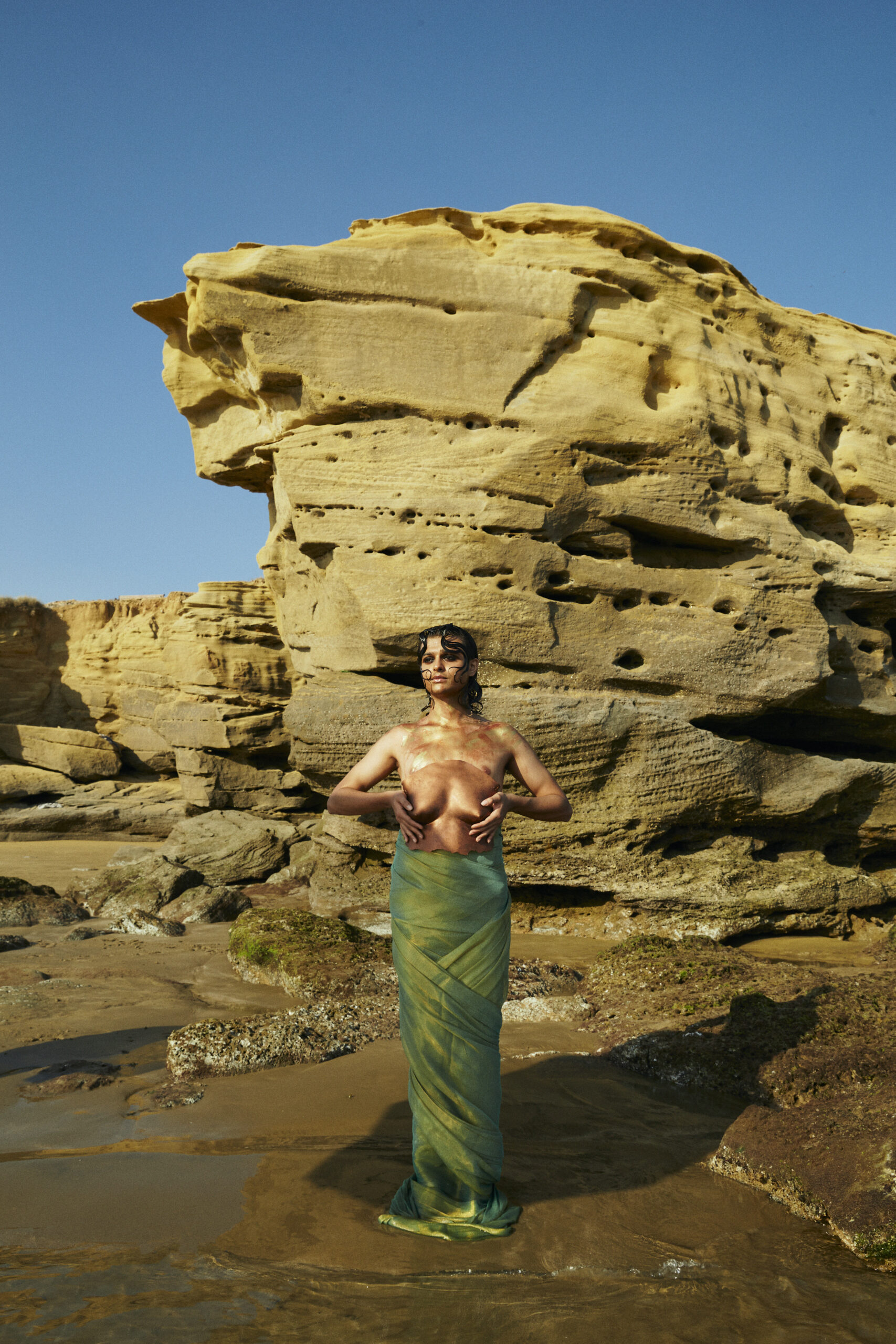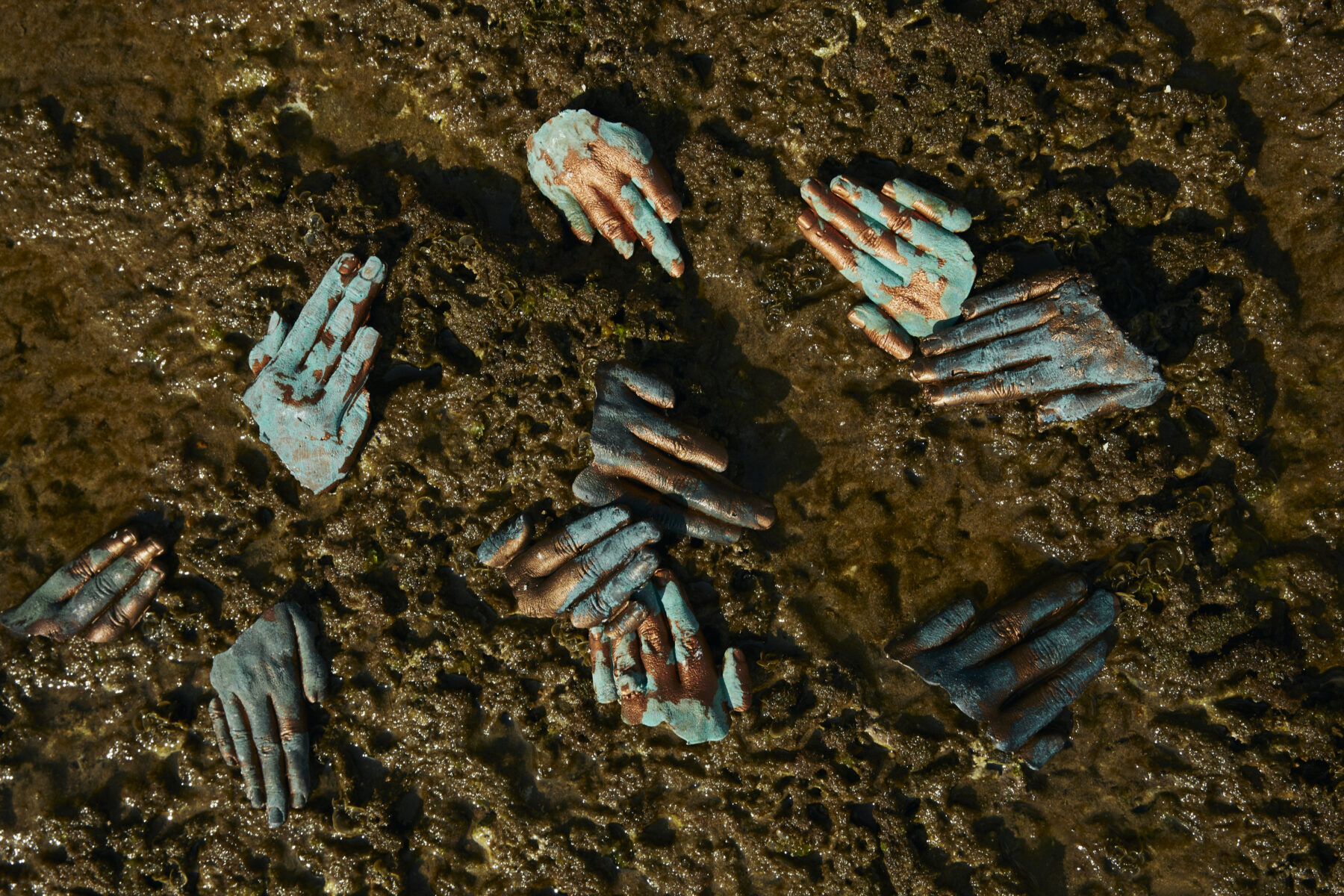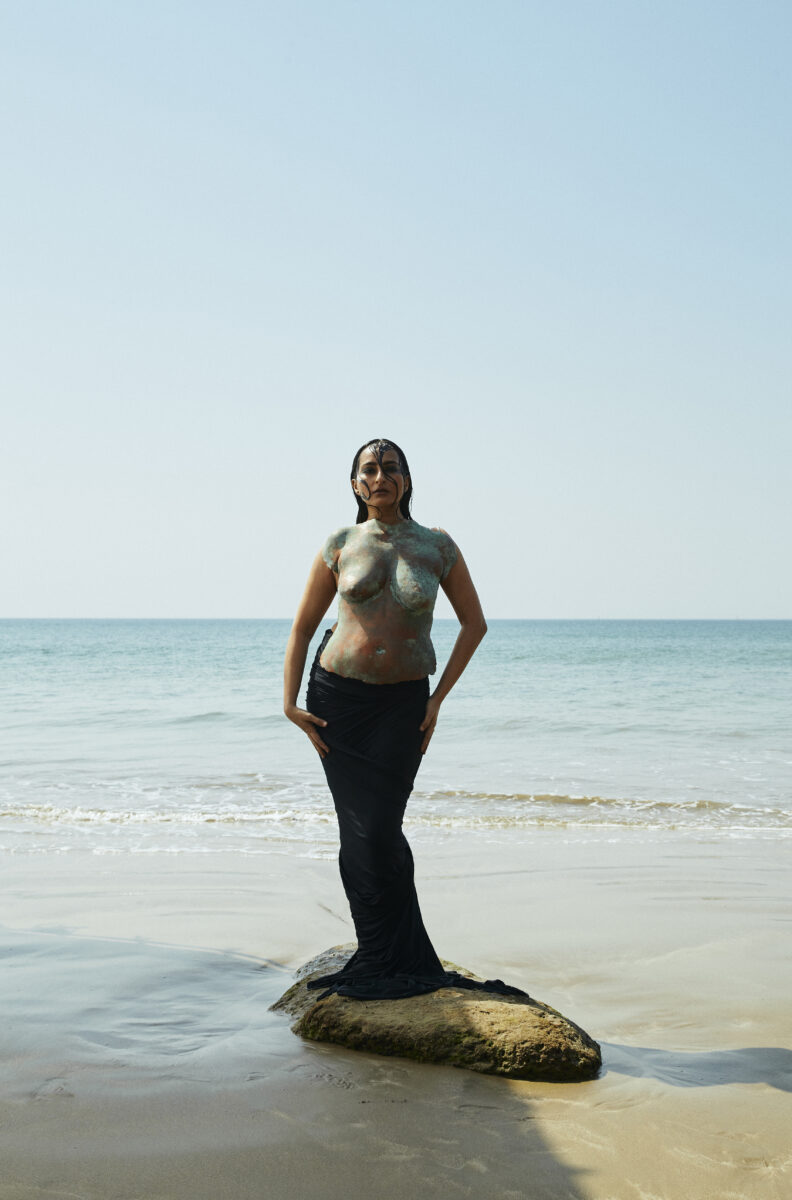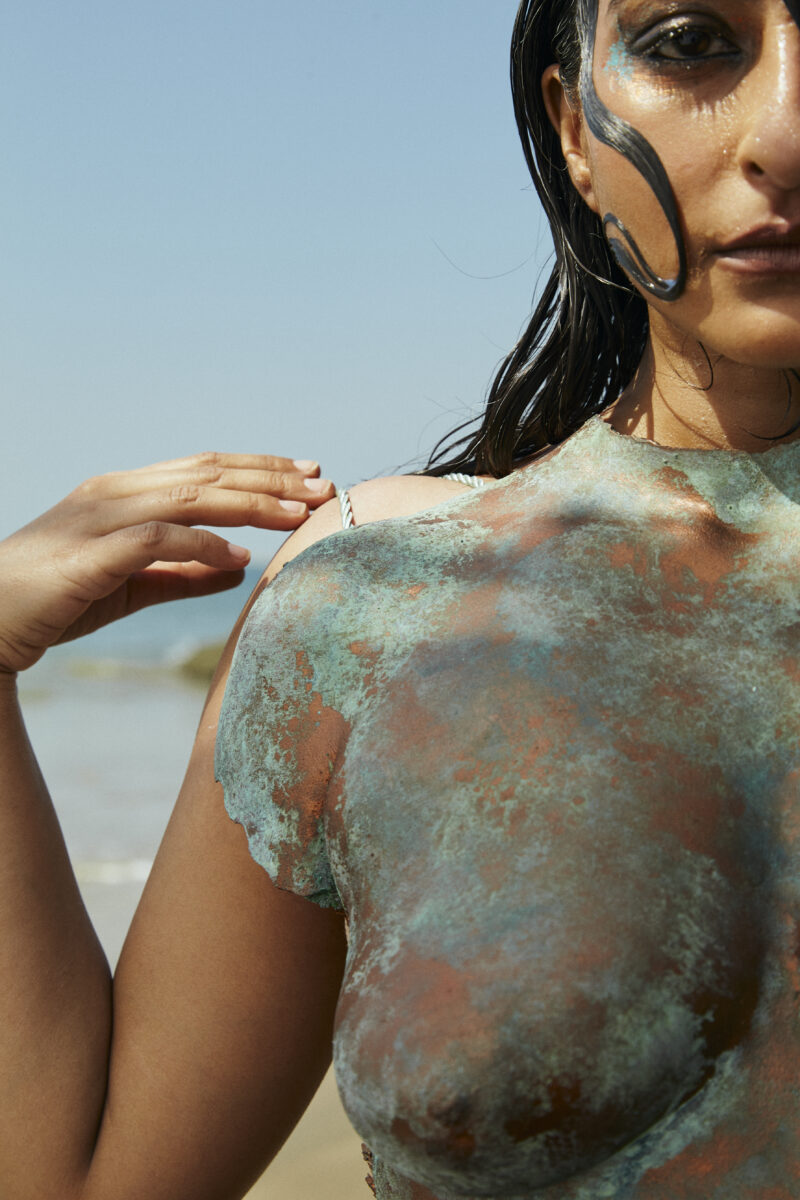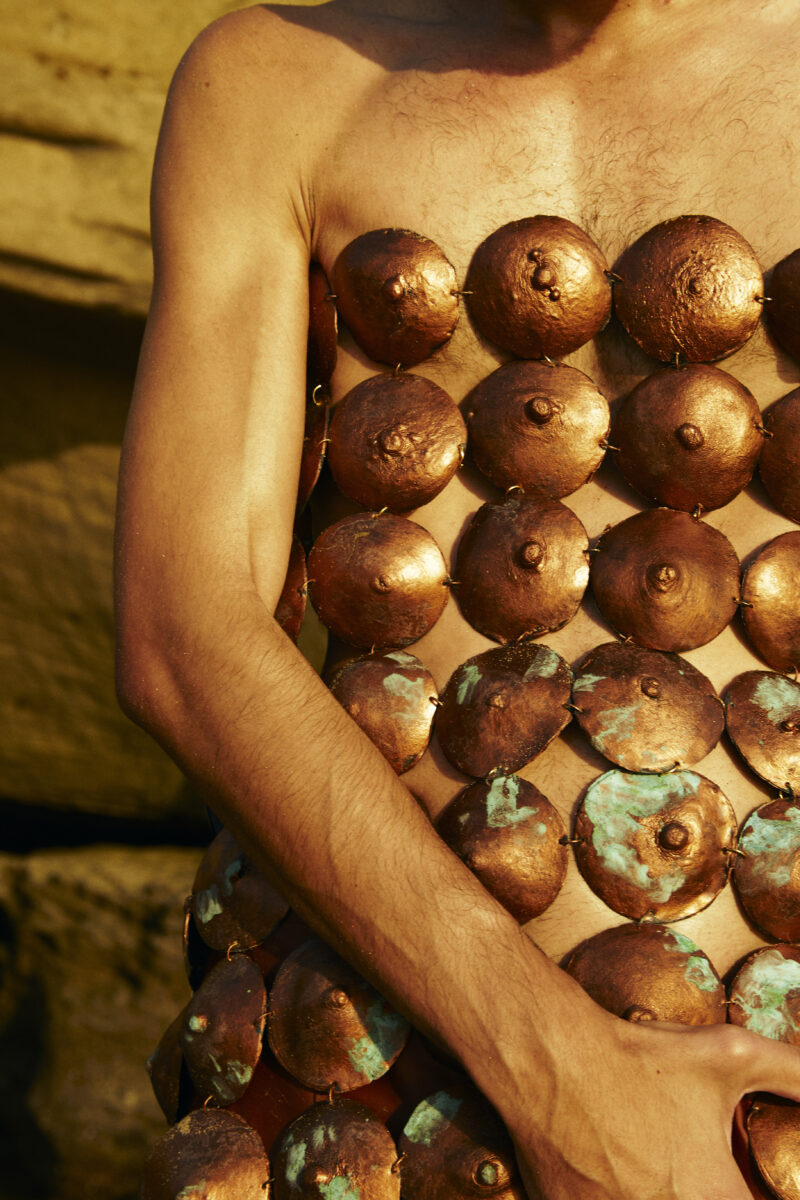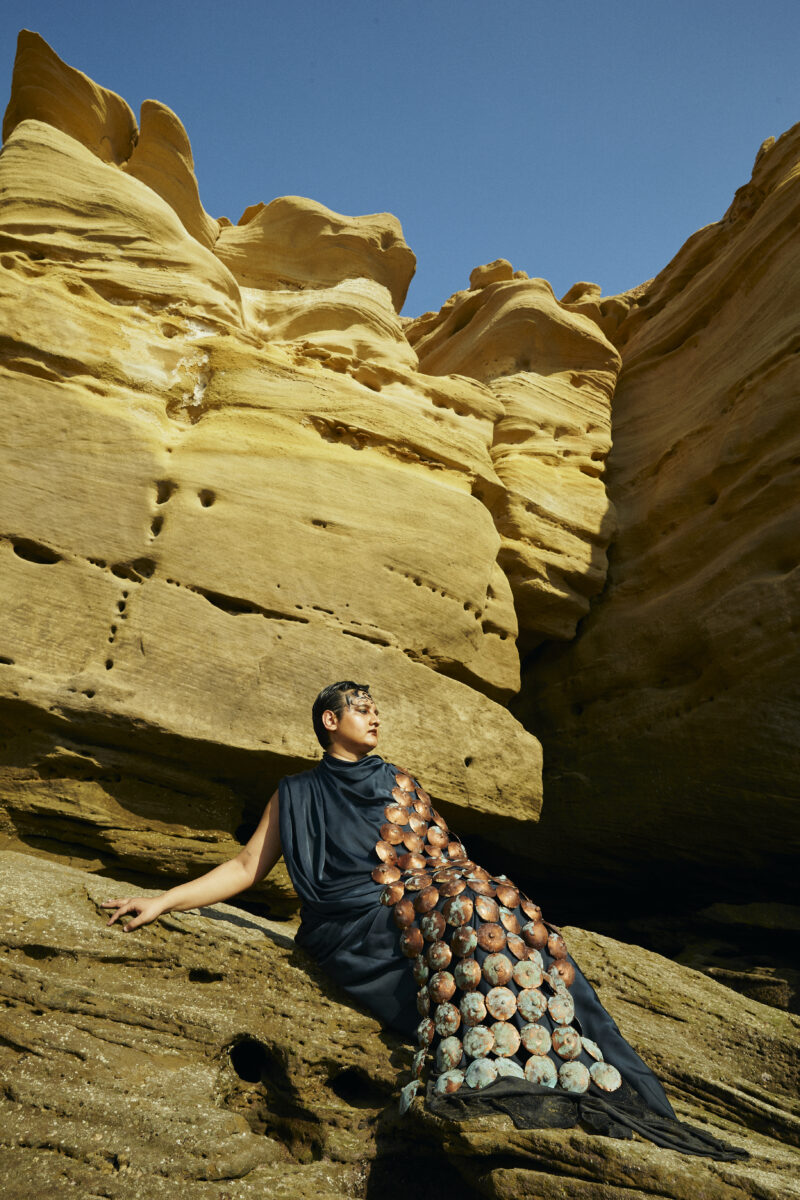New York – Imagine a new era for humanity. Millennia from now, empires have risen and fallen, and societies have grown, blended, shifted, and survived. Imagine a beach. Imagine this new era still has shores to be looked out upon that inspire wonder for places we don’t yet know. Imagine we have not yet learned too much about ourselves that we may still feel the excitement of discovering something unexpected.
Now, imagine someone, someone whom we will never meet, who walks along this shore and discovers something poking out from the sand. Imagine they pull it out from the sand. It’s a form, one of a human. Shoulders. Breasts. A back. An abdomen. It’s a casting of resin with coated metals of bronze, copper, and gold.
What would this “someone” who discovered this casting imagine of the people who created it? Would the words, the people, the genders, the parts, and the histories that we know of this artefact be the same ones that they would use for it a thousand years from now? Would they be able to find the city in which this artefact was created, the person it is modelled after, and the person that made it? Would they know why they did it; the histories that motivated it; the divisions that required it; the ancestors who inspired it; the care and consideration put into it; the people that gathered to discuss it; the joy they found in it? Would that be preserved?
In her first solo exhibition, Beghairati Ni Kishaani: Traces of Shamelessness, which was open at Hannah Traore Gallery from May 4th through July 30th, Pakistani artist and designer Misha Japanwala pondered this future and attempted to aid in our preservation. With her stunning mouldings of hands, nipples, and breastplates from Pakistani muses, she created literal embodiments of history and culture through physical stories. The resin mouldings with metal coatings bare a striking callback to antiquity, establishing her work as preternaturally historic.
In the short film that she made of the same name, she worked with Pakistani executive producer Meetra Javed along with celebrated Pakistani musician Ali Sethi to imagine such a beach in the future that her works may one day be found in Karachi, Pakistan, which featured the same models the works were moulded after- queer, trans, and femme creators from Pakistan.
I watched the film in the corner of Hannah Traore Gallery, which opened only a little over a year ago, an impressive space on Orchard Street with a sizable front hall where a talk between the filmmakers would be held. Every seat was filled, and the remaining space of the hall was roaring with anticipatory chatter and excitement. Many seemed to be old friends who happened to both be reuniting in the space. Some were strangers, both interested in Japanwala and her work. Some seemed to be members of the Pakistani community of New York who just came to come and be amazed to see such incredible, resonant, timeless works featured on the walls of a gallery. “The first time I moulded my body and saw a cast of it in real life was a really profound moment for me in my artistic practice,” she later told me. “It really confirmed the need and the urgency to create the kind of work that I do.”
Though the show had been enjoying an incredible press run for a debut solo show at a year-old gallery, it came as no surprise as Japanwala has been making waves in the fashion world for years for her custom pieces for celebrities like Lizzo, Gigi Hadid, and most notably Lupita Nyong’o, who wore a custom breastplate to the Tony Awards. “There’s never a planned conversation,” she told me. “I think something that’s the most beautiful about the conversations that I had is how organically they unfold and the kinds of things people feel compelled to share just because we’re engaging in this artistic process and this way of creation.”
About twenty minutes after I arrived, as the hall filled with excited onlookers, the talk began between Japanwala, Sethi, and Javed about the creation of the film, which Javed directed and produced. They explained to us the extreme backstory of the shootdate. To feature such bodies, wearing such striking, “nude” garments on the beach of Pakistan, is an extremely dangerous act in a conservative, religious society. The film endured pressures from the government to halt the filming altogether, which Japanwala and Javed muscled through regardless, for Japanwala was certain she wanted the film to be created on the very same beach she hoped the works would be discovered upon one day. “In the development of this project,” she told us, “all of the pieces of this body of work are presented as future artefacts. And my vision for these pieces was this imagination of recording people’s shamelessness in the present day when we can control the narrative of the way our bodies and our shamelessness are spoken about and for that to stand the test of time.”
There was something special about how brazen the work was in its nudity and the irony of it appearing in armour, almost as if anyone in this room could run up and wear it themselves if need be. But it was the openness, the “shamelessness” of such an armoury of queer, femme, and trans, brown bodies that elicited an atmosphere of safety. “Her breastplate renders the wearer both ‘covered’ (in metal, like a battle-ready warrior) and also ‘exposed’ — a paradox that brings to mind the mystical poetry of where we grew up,” Sethi later told me.
It was important to Japanwala that those featured in the project, her muses, felt that safety before even seeing the results. “To show up and be a part of something when you know the country you live in can and will crucify you is brave,” said Javed. “I really learned so much from them embodying [Japanwala] ‘s work.” She later told me, “Speaking to all of the artists cast in the project felt like a defying moment in my life,” she recounted. “The conversations and audio takes were not used for the film in the end – but I empathised with the struggles and gifts of each individual in a more meaningful way —they are fighting for their truths and their rights to exist.”
She explained to us that, due to the powerful nature of Sethi’s score and how easily it embodied the message of the work, they decided to let the work speak for itself over Sethi’s song.
“Now here’s the paradox of what you’re saying,” Sethi responded, “you’re describing what is a very contemporary and progressive form of artistry and activism as is embodied in these people we see in this video, but the song is very traditional.” He went on to ask us to consider the complications of having a song that is rooted in Indo-Persian-Muslim song tradition that fits so well with work that would be considered by a conservative in these traditions as Western-style shamelessness. “You’re told you’re shameless,” he explained, “and yet to still be able to communicate through your truth, through beauty, and to not surrender to that allegation of, ‘You’re in that camp,’ or ‘You’re a fifth colonist, you’re a western lobby,’ which is something I think all of us have confronted at one point or another, I that’s also a triumph of this project that I am very proud of.'”
I felt something strange as I looked around, something I at first was not proud of. It was bizarre to me to see so many brown people in such a pristine, elevated gallery space—no, it felt stranger that so many brown people were dominating such a space. The looseness in the air, the unadulterated pride in seeing these mouldings of brown bodies featured on these walls, the comfort with which these collaborators spoke of such complicated subjects of diaspora and representation, it felt unnatural to everything I was familiar with in a New York gallery space. I almost began to feel that I wasn’t supposed to be in this space, which I feel in almost every high-level gallery space I’ve been to. I can hardly think of any space in New York where I’d experienced such a thing besides the homes of my relatives.

What was truly unique about this work was the same sort of shock the space itself elicited in me. So often, it feels that if they have any hopes of being commercially successful, artists of colour are meant to either create work that any person can attach a vague personal meaning to or create work that is so overtly identity-oriented that the personality of the artist is on the line in every sale.
That isn’t the case here. These mouldings from Japanwala’s muses, whose identities are integral to the meaning of the work, retained aesthetic excellence while radiating with meaning. This is not at all to suggest that art that is attached to identity cannot hold aesthetic excellence, but rather that it is rare to find a gallerist in New York who cares enough to aesthetically strong art made by people of colour whose commercial success does not rest too heavily on identity. Artists of colour should be afforded the ability to experiment with form, style, material, and storytelling while retaining an attachment to background and history, not having to choose one or the other.
And maybe there’s something to be learned from the rapturous success of the 28-year-old rising star gallerist Hannah Traore, the namesake of the gallery, who humbly crouched down next to the audience, electing to have Japanwala lead her own talk while she excitedly snapped photos and videos. Traore explained to me after the talk was over that before even starting the gallery, she made a list of every artist she hoped to work with, Japanwala being one of the first. Though Japanwala had never had a solo exhibition, Traore committed to collaborating with her, even chasing after her on Instagram after a case of missed emails. Japanwala immediately answered, and they got dinner. “I forgot it was a work meeting,” she mused. “For me, owning a small gallery, that’s such a big part of it as well, the connection I have with the artist.” Before having even seen Japanwala’s studio, they agreed on a show and began ideating together. “This is my favourite part of being a gallerist, is being on the journey with my artist. Especially when they trust me, and I trust them, because it’s like, it really feels like a collaboration and like a dialogue.”
With collaborations like Helmut Lang Seen by Antwaun Sargent: “YOBWOC,” which saw the famed young Gagosian director exploring the historical significance of the Black cowboy through the heritage fashion house, Traore has made a name for herself as someone with an incredible taste for experimental artists of colour who are itching for the opportunity to let loose beyond what is commercially simple. While Japanwala has been creating mouldings for years, the depth and political implications of this show and its central theme of “shamelessness” consecrated her otherwise commercial art practice into one of great community potential.
“This is my favourite part of being a gallerist,” said Traore, “being on the journey with my artist, especially when they trust me, and I trust them. It feels like a collaboration. We would have meetings, and she would tell me about where she was in the process, in terms of the concept, way before even the physical part of it.” To have had a space like this, owned and run by a gallerist of colour, representing artists of colour, with a focus on making commercial art spaces accessible to the same people the art is about, it felt like a miracle, though it shouldn’t have. “I measure success in the way it’s received, specifically by the community who wants more,” Traore revealed. She admitted that it would be nice if the Chelsea gallery world paid more attention to her—although they may soon have no choice but to pay attention—their attention is not her priority. “A woman came in today and said that the South Asian community was talking about [the show] because that’s who it’s for. It’s for us, you know?”
I began to feel at ease as their conversation went on because of how at ease they were. These collaborators (who were strangers before coming together behind Japanwala’s ideas) laughed and contemplated together in ways that made me, and I’m sure many in the audience, feel safe. We were at home, here, in the aftermath of this work. A triumph not only for the artist, but for her community and every community who sees themselves in this work. It felt like witnessing history. A shame, a feeling of un-belonging, had been washed away. One day, in another time, may it be remembered by those who chose to remember it so that others may break free.
“To say the least, there is a long way to go for a lot of people who still shame bodies and sexuality,” Javed later told me. “It’s taboo, and we have some unlearning to do – but this experience has strengthened my relationship to my roots. I’m sure there are a lot of people who wonder why I chose to be a part of something like this—but my answer is we need to relieve ourselves of our comfort zones and ask ourselves, ‘Why is this making me uncomfortable? Why is so much of this alienating?’ It shouldn’t be. The body is beautiful – it is to be celebrated in all of its forms.”
Written by Saam Niami. All images courtesy Misha Japanwala.
